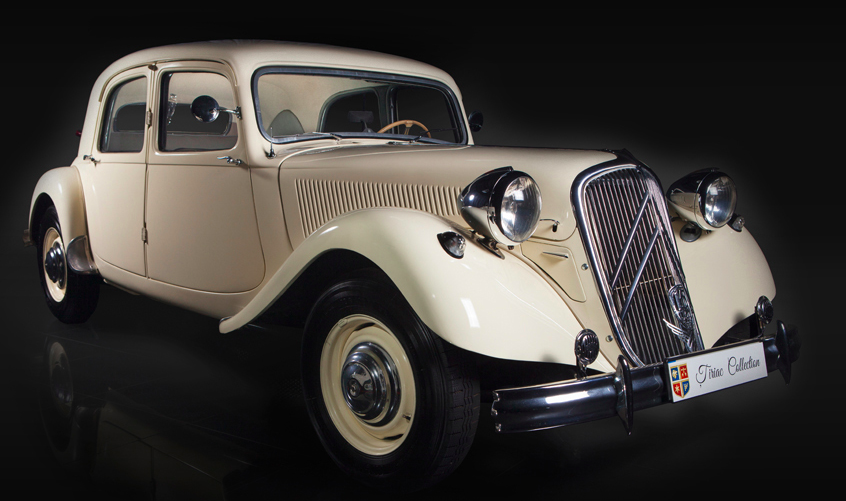1952 Citroën 15 Six D

The descriptions of the Classic Cars in the Directory were partly generated or supplemented with the help of artificial intelligence (AI). The content may occasionally not always be entirely accurate or factually correct despite careful checking.
The Citroen 15 Six D, produced in 1952, is one of the most technically advanced cars of its time. Its main features are remarkable elegance and extravagant design, distinctive from other vehicles of its era.
This vehicle boasts an avant-garde suspension system that sets it apart from other cars of its time. The hydraulic suspension, developed by Citroen and known as the "Hydro-pneumatic" suspension, was the first of its kind ever to be installed on a mass-production vehicle. This system allowed for the car to adapt to any road condition, yet providing superb driving comfort. The suspension ensured that the car could maintain a level body position, despite the unevenness of the terrain, whereby maintaining optimal contact with the road. With this Citroen 15 Six D, every driver, even with little experience, could feel like a professional rally driver.
The car is powered by a six-cylinder engine with overhead valves, delivering 77 horsepower, which was one of the most powerful engines of the era. The engine specs for a vehicle of its class were rather impressive, with a mere 2.9 L displacement. The powerplant was paired with a four-speed manual transmission, making for a truly dynamic driving experience.
The interior of the Citroen 15 Six D is both elegant and comfortable, featuring a bench seat that could seat six adults, the largest seating capacity for any car of its era. The vehicle's dashboard was vast, featuring a series of dials that displayed information on various aspects of the car's performance, such as the speedometer, fuel gauge, and temperature gauge.
The Citroen 15 Six D was the first-ever car to feature power brakes, which were hydraulic-powered. This feature increased the vehicle's driving experience and the driver's confidence on the road. Additionally, the brakes were coupled with a regenerative system that allowed for energy recovery every time the driver applied the brakes.
The car's exterior design was equally revolutionary, featuring a streamlined body that set the standard for modern-day automotive design. The body was sleek and aerodynamic, characterized by its rounded curves and concave grill that give it a unique look. Additionally, the car had bumpers that were integrated into the bodywork, smoothing the overall design.
In conclusion, the Citroen 15 Six D of 1952 is a true masterpiece of automotive engineering. The car's unique features, such as its avant-garde suspension, six-cylinder engine, and power brakes, combined to make this vehicle stand out from other models of cars during its time. The Citroen 15 Six D's sleek bodywork and elegant interior design, along with its innovative components, made it a vehicle that was ahead of its time, with many of its features resembling those of modern-day vehicles. For anyone who loves classic and innovative cars, the Citroen 15 Six D is a must-own vehicle.
Milestones
- Citroen 15 Six D introduced in 1952 as an upgraded version of the Citroen 15 Six - Equipped with a 2.9-liter six-cylinder engine, generating 77 horsepower - Featured hydropneumatic suspension system, which provided a smoother ride and better handling - Introduced a new dashboard design with a speedometer and gauges placed in front of the driver - Offered as a sedan, convertible, and station wagon - Extended wheelbase version also available, known as the Citroen 15 Six D Familiale - Won the 1952 Monte Carlo Rally with a modified version of the car - Production ended in 1955, with approximately 12,000 units produced.Technical
- Engine: 2.9-liter, six-cylinder engine - Horsepower: 78 hp - Transmission: Four-speed manual gearbox - Suspension: Independent front and solid rear axle with leaf springs - Brakes: Hydraulic four-wheel drum brakes - Steering: Worm and roller steering - Wheelbase: 2,880 mm (113.4 in) - Length: 4,720 mm (185.8 in) - Width: 1,740 mm (68.5 in) - Height: 1,600 mm (63.0 in) - Weight: 1,275 kg (2,811 lb) - Top speed: 86 mph (138 km/h) - Fuel consumption: 15-20 mpg (city/highway) - Production years: 1949-1955 - Production quantity: 8,982 units built.